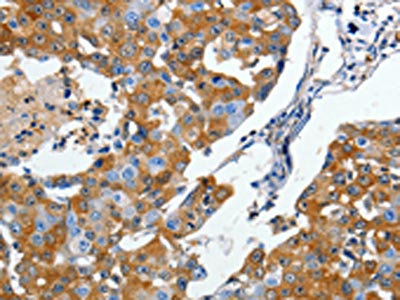CRMP5 antibody [N1C1]
GTX112287
ApplicationsImmunoFluorescence, Western Blot, ImmunoCytoChemistry, ImmunoHistoChemistry, ImmunoHistoChemistry Paraffin
Product group Antibodies
TargetDPYSL5
Overview
- SupplierGeneTex
- Product NameCRMP5 antibody [N1C1]
- Delivery Days Customer9
- Application Supplier NoteWB: 1:500-1:20000. ICC/IF: 1:100-1:1000. IHC-P: 1:100-1:1000. *Optimal dilutions/concentrations should be determined by the researcher.Not tested in other applications.
- ApplicationsImmunoFluorescence, Western Blot, ImmunoCytoChemistry, ImmunoHistoChemistry, ImmunoHistoChemistry Paraffin
- CertificationResearch Use Only
- ClonalityPolyclonal
- Concentration1.01 mg/ml
- ConjugateUnconjugated
- Gene ID56896
- Target nameDPYSL5
- Target descriptiondihydropyrimidinase like 5
- Target synonymsCRAM, CRMP-5, CRMP5, CV2, RTSC4, Ulip6, dihydropyrimidinase-related protein 5, CRMP3-associated molecule, DRP-5, ULIP-6, UNC33-like phosphoprotein 6, collapsin response mediator protein-5
- HostRabbit
- IsotypeIgG
- Protein IDQ9BPU6
- Protein NameDihydropyrimidinase-related protein 5
- Scientific DescriptionMembers of the CRMP family, such as DPYSL5, are believed to play a role in growth cone guidance during neural development.[supplied by OMIM]
- Storage Instruction-20°C or -80°C,2°C to 8°C
- UNSPSC12352203
References
- Zeng HY, Liu Q, Peng XY, et al. Detection of serum anti-retinal antibodies in the Chinese patients with presumed autoimmune retinopathy. Graefes Arch Clin Exp Ophthalmol. 2019,257(8):1759-1764. doi: 10.1007/s00417-019-04359-2Read this paper
- Saito M, Saito W, Kanda A, et al. A case of paraneoplastic optic neuropathy and outer retinitis positive for autoantibodies against collapsin response mediator protein-5, recoverin, and α-enolase. BMC Ophthalmol. 2014,14:5. doi: 10.1186/1471-2415-14-5Read this paper


![IHC-P analysis of human brain tissue using GTX19378 CRMP5 antibody [CR-1]. Left : Primary antibody Right : Negative control without primary antibody Antigen retrieval : heat induced antigen retrieval was performed using 10mM sodium citrate (pH6.0) buffer, microwaved for 8-15 minutes Dilution : 1:20](https://www.genetex.com/upload/website/prouct_img/normal/GTX19378/GTX19378_1072_IHC-P_w_23060620_700.webp)

![IHC-P analysis of human glioma tissue using GTX19352 CRMP5 antibody [CR-3]. Left : Primary antibody Right : Negative control without primary antibody Antigen retrieval : heat induced antigen retrieval was performed using 10mM sodium citrate (pH6.0) buffer, microwaved for 8-15 minutes Dilution : 1:50](https://www.genetex.com/upload/website/prouct_img/normal/GTX19352/GTX19352_1070_IHC-P_w_23060620_891.webp)


